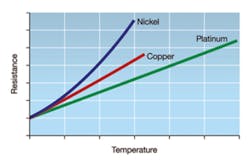Temperature is the most measured parameter across many applications and industries. Resistance Temperature Detectors (RTDs) and thermocouples are the most common sensor types used in industrial processes. But which is the best choice for an application and process? This question comes up regularly in discussions at plants, engineering procurement companies, engineering firms, and elsewhere. The following information should provide guidance in the selection process to gain accuracy, repeatability and stability.
What Are the Basics?
The first step in making the decision is to understand your process and its performance requirements. Ask yourself:
- What is the temperature range I am trying to measure?
- What is my required measurement accuracy level?
- What are the process vibration concerns?
Other more general areas to keep in mind, regardless of your choice between an RTD or thermocouple, include: the sensor should not be influencing the media in which it is inserted; response time is dependent on the size and mass of the sensor element (assuming no predictive method is used); and accuracy can be affected if concerns around stem effect are not addressed.
What Is an RTD?
An RTD is based on the principle that the electrical resistance of a metal increases as temperature increases (thermal resistivity). RTDs are made of several materials including Nickel, Copper and Platinum (most common). Platinum can be used over a wide range of temperatures and provides a quick response time, as well as being chemically stable. RTDs can be supplied as a wire-wound element offering a higher temperature range (-200 C to 850 C) or as a thin-film element that is better able to withstand vibration.
The advantages of RTDs are as follows:
- Range: -200 C to 850 C
- Drift: Long-term drift is small and predictable
- Sensitivity: Excellent sensitivity over narrow spans
- Linearity: Exhibits excellent linearity
- Cost: Inexpensive connection wire
- Interference: Low susceptibility to EMI & RFI
- Lifespan: Many years, but shorter at higher temperatures
The voltage drop across an RTD also provides a much more robust output than a thermocouple. RTDs can also be supplied with Callendar-Van Dusen (CVD) calibration constants for sensor-transmitter matching, producing incredible measurement precision.
As for some disadvantages, RTDs are more expensive and rarely used above 660 C. They are also less sensitive to small temperature changes and have a slower response time.
What Is a Thermocouple?
A thermocouple is a closed-circuit thermoelectric temperature sensing device consisting of two wires of dissimilar metals joined at both ends. A current is created when the temperature at one end or junction differs from the temperature at the other end. This is also known as the Seebeck Effect.
Thermocouples fall into two groups: Base Metal -200 C to 1200 C (-328 F to 2192 F) and Precious Metal 1000 C to 1800 C (1832 F to 3272 F). There are also multiple thermowell styles available, including grounded, ungrounded, uninsulated, and insulated.
The advantages of thermocouples include:
- Range: -270 C to 2300 C
- Wire: heavy gage wire can with stand high vibration
- Cost: generally cost less than most RTDs
Thermocouples are used for temperature measurement for kilns, gas turbine exhaust, diesel engines, other industrial processes, and fog machines. They can be made smaller in size than most RTDs, so they can be formed to fit a particular application. As for disadvantages, one is decreased accuracy, particularly at elevated temperatures. Thermocouples are also difficult to recalibrate, depending upon the environmental conditions. They may also be expensive if long lead wires are needed, especially for the precious metal thermocouple types.
Comparing RTD & Thermocouple Attributes
Now that you know some of the advantages and disadvantages of both, consider a side-by-side comparison of their attributes.
In general, thermocouples are better than RTDs when it comes to overall cost, durability, measurement speed, and temperature range. RTDs provide readings that are both more accurate and repeatable.
Things to Keep in Mind
When selecting between an RTD and thermocouple, keep in mind the temperature range you want to measure. Thermocouples are capable of handling a higher range than RTDs. Second, consider the level of measurement accuracy you want to gain. In general, RTDs are more accurate than thermocouples, and optimal accuracy can be achieved by utilizing transmitter and sensor matching with RTDs. A third consideration is process vibration. Thermocouples have the highest vibration resistance.
Ashleigh Hayesis an engineer, specializing in temperature sensors and transmitters for Emerson Process Management. She has a bachelor’s degree in Electrical Engineering from the University of St. Thomas and is currently in the MBA Program at University of Minnesota, Carlson School of Management. Ms. Hayes is an active member in the Society of Women Engineers (SWE)-Minnesota.
www.rosemount.com
To order a free copy of The Engineer’s Guide to Industrial Temperature Measurementfrom Emerson Process Management, visit flwctrl.com/emerson_tempguide
